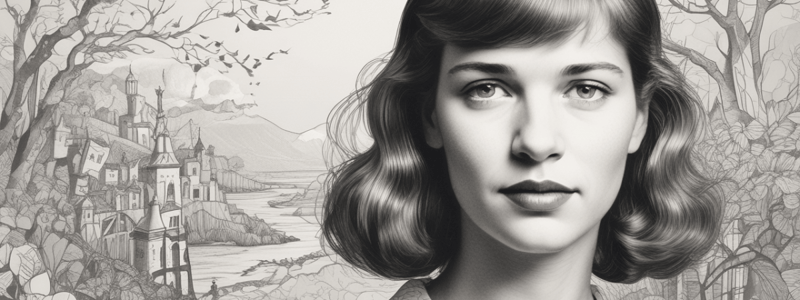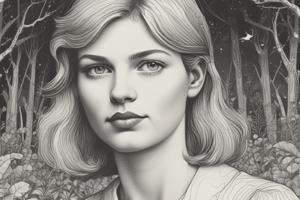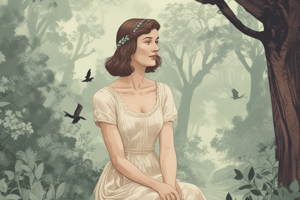Podcast
Questions and Answers
What is the central concept that Plath explores through the hobby of beekeeping in 'The Arrival of the Bee Box'?
What is the central concept that Plath explores through the hobby of beekeeping in 'The Arrival of the Bee Box'?
- The struggle for control (correct)
- The beauty of the natural world
- The importance of friendship
- The power of nature
What literary device is used in the line 'Square as a chair'?
What literary device is used in the line 'Square as a chair'?
- Personification
- Metaphor
- Hyperbole
- Simile (correct)
What is the effect of the assonance in the line 'Were there not such a din in it'?
What is the effect of the assonance in the line 'Were there not such a din in it'?
- It creates a jarring, cacophonous sound (correct)
- It conveys a sense of nostalgia
- It creates a sense of calm
- It emphasises the beauty of the bees
What is the significance of the monosyllables in the last line of the first quintet?
What is the significance of the monosyllables in the last line of the first quintet?
What is the tone of the speaker in the first two lines of the poem?
What is the tone of the speaker in the first two lines of the poem?
What does the box of bees represent in Plath's thoughts and feelings?
What does the box of bees represent in Plath's thoughts and feelings?
What does the image of 'African hands' convey?
What does the image of 'African hands' convey?
What is the significance of the 'unintelligible syllables' uttered by the bees?
What is the significance of the 'unintelligible syllables' uttered by the bees?
What does Plath's 'moon suit and funeral veil' represent?
What does Plath's 'moon suit and funeral veil' represent?
Flashcards
Plath's Mental Health
Plath's Mental Health
Sylvia Plath's struggles with her mental health, evident in the poem through intrusive thoughts and feelings
Depression in "The Bee Box"
Depression in "The Bee Box"
The poem explores the experience of depression as illustrated through the poet's internal conflict, represented by the bee box.
Control and Intrusive Thoughts
Control and Intrusive Thoughts
The poem examines the poet's attempts to control her thoughts, represented by the bees' confinement in the box.
Repetition in "The Bee Box"
Repetition in "The Bee Box"
Signup and view all the flashcards
Figurative Language (Simile)
Figurative Language (Simile)
Signup and view all the flashcards
Figurative Language (Metaphor)
Figurative Language (Metaphor)
Signup and view all the flashcards
Imagery in "The Bee Box"
Imagery in "The Bee Box"
Signup and view all the flashcards
Bee Box as a Symbol
Bee Box as a Symbol
Signup and view all the flashcards
Overwhelming Thoughts
Overwhelming Thoughts
Signup and view all the flashcards
Poem's Temporary Nature
Poem's Temporary Nature
Signup and view all the flashcards
Study Notes
The Arrival of the Bee Box by Sylvia Plath
Themes and Ideas
- Mental Health: Plath struggles with her mental health while writing this poem, reflecting on her intrusive thoughts and feelings
- Depression: The poem explores the concept of depression and the poet's experience with it
- Control: The poem considers the concept of control, with the bees representing Plath's thoughts and feelings
- Intrusive Thoughts: The bees symbolize the intrusive thoughts and feelings Plath contends with
Style
- Repetition: Anaphora (repetition of the same word at the start of consecutive sentences) is used to create a sense of rhythm and emphasis
- Figurative Language: Similes (e.g., "Square as a chair"), metaphors (e.g., "coffin of a midget"), and personification (e.g., "petticoats of the cherry") are used to create vivid imagery
- Imagery: Taken from the natural world, with a focus on the bee box and its contents
Analysis of Key Quotes
- "I ordered this, this clean wood box": Plath comments on the box's appearance, using anadiplosis to slow down the pace and create a respectful, cautious tone
- "Square as a chair and almost too heavy to lift": A simile that creates a visual image, with the "almost" implying a sense of burden
- "I would say it was the coffin of a midget / Or a square baby": A strange and twisted visual image, with the use of enjambment carrying the thought forward
- "Were there not such a din in it": A cacophonous line with assonance, creating a jarring sound that evokes the bees' noise
- "I have to live with it overnight / And I can't keep away from it": A sense of tension and attraction to the box's contents
Bee Box Imagery
- The box is described as "locked" and "dangerous", with the bees inside representing Plath's thoughts and feelings
- The "grid" allows Plath to observe the bees, with the repetition of "dark" creating an ominous atmosphere
- The image of "African hands" connotes slavery and oppression, with Plath seeing herself as the coloniser
Plath's Thoughts and Feelings
- The bees represent Plath's intrusive thoughts and feelings, with the "unintelligible syllables" suggesting they are communicating in their own language
- The poem explores the idea that individual thoughts may be manageable, but together they become overwhelming
- Plath wonders if she might be forgotten if she were to undo the locks and become one with nature
- The final line, "The box is only temporary", suggests that nothing is permanent, not even suffering
Studying That Suits You
Use AI to generate personalized quizzes and flashcards to suit your learning preferences.




